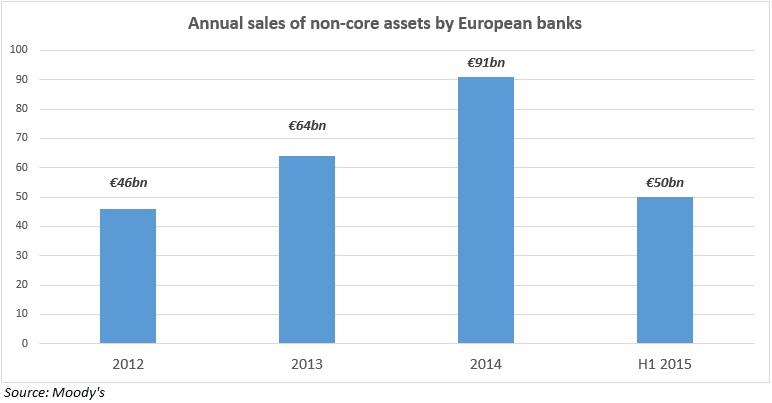European banks will accelerate sales of non-core assets this year, boosting the growing private debt pipeline, according to a new report from Moody’s.
Private debt funds have blossomed in the past three years as banks have deleveraged their balance sheets and begun disposing of non-core and non-performing loans.
The credit rating agency said banks had sold more than €201 billion ($224.8 billion) of assets between 2012 and 2014, and a further €50 billion in the first six months of 2015.
 Despite these sales, most deleveraging has been through
changing derivatives exposures and increasing capital reserves, Moody’s Credit
Policy Analyst Antonio Garre said—indicating there is a significant volume of
assets still to come to market.
Despite these sales, most deleveraging has been through
changing derivatives exposures and increasing capital reserves, Moody’s Credit
Policy Analyst Antonio Garre said—indicating there is a significant volume of
assets still to come to market.
“Rather than the reduction in outstanding credit being driven by sales of non-performing loans, banks have instead been reducing the provision of performing loans,” he added.
“Private debt funds are a rapidly growing alternative lending sector in Europe and we expect them to see continued growth over the next year,” said Soo Shin-Kobberstad, senior analyst in Moody’s Financial Institutions Group.
Shin-Kobberstad said managers had been increasing their capital raising targets in an effort to take advantage of a forthcoming regulatory review of the quality of banks’ assets.
However, Moody’s also cast doubt on the overall ability of non-bank lenders—including asset managers—to offset the shortfall of provision from banks. Based on the current pace of sales, the data agency indicated that supply would continue to outpace demand.
Earlier this year, data company Preqin reported that global private debt fund assets were approaching $500 billion. Funds had $154 billion in dry powder in March, the group said.
Related: Private Debt’s Gathering Clouds & A How-To Guide to Private Debt
